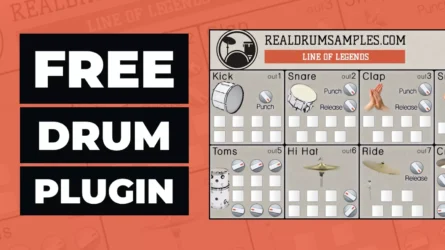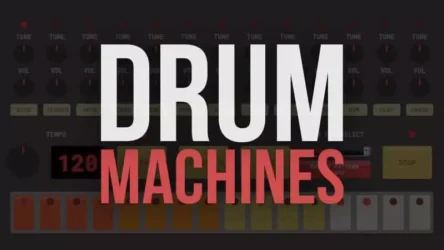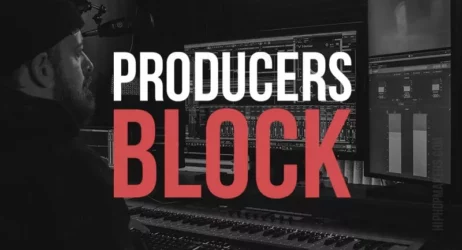In this guide we will answer what a vocoder is, how they work, share vocoder music examples, and how to create the vocoder effect yourself.
- What Is A Vocoder
- Examples of Songs With Vocoders
- How Does A Vocoder Work
- What Do I Need To Use A Vocoder
- Is Vocoder The Same As Autotune
- Who Invented The Vocoder
- What Is A Vocoder Used For
- How Can I Do The Vocoder Effect
What Is A Vocoder?
A vocoder (voice coder) is an analyzing and synthesizing system, which means it can break an audio signal down into components and recreate those components with vocoder effects. For this reason, it is also known as a voder and a voice encoder.
Like many other electronic music instruments, vocoders allow the user to change the harmonic content of the input signal. This is done by creating formants or “formant tracks” for speech or singing, which can be done by changing the volume of a harmonic tract.
When a user changes these volume levels, he changes what frequencies are heard.
In addition to changing what frequencies are heard, a vocoder can add or subtract frequencies to make partials that are not harmonically related to the original signal.

In simple terms, a vocoder is used to modify how you sound by changing what you say into what the vocoder says. The vocoder has many uses, including what is known as the robotic effect – making you sound like a robot.
What Are Different Types of Vocoders?
Vocoders can be divided into four categories: classic, vowel, formant, and spectral.
Classic Vocoder
A classic vocoder analyzes the input signal into 10 bands, then synthesizes the signal into another 10 bands.
Spectral Vocoder
The spectral vocoder uses a bank of fast Fourier transforms to break down the input signal and uses parallel filters to form what is known as a spectral envelope. This means the frequency bands determine what frequencies are heard.
Vowel Vocoder
A vowel vocoder creates what is known as formant tracks, meaning the user can change what vowels they like.
Formant Vocoder
This is a combination of what is known as the spectral vocoder and what is known as the vowel vocoder. It allows the user to get formant tracks and frequencies that make you sound like a particular vowel.
What Music Genres Use Vocoders?
Many artists have used vocoders in all genres of music, including classical tracks such as Electric Light Orchestra’s “Mr. Blue Sky” and even hip hop songs such as Daft Punk’s “Technologic.”
However, some artists use vocoders more than others. For example, the Daft Punk song “Robot Rock” uses vocoder in almost every aspect of the song.
Music genres such as electro, pop, disco, and even hip hop can be called vocoder-heavy genres.
Related: 10 Free Vocoder VST Plugins
What Are Examples Of Songs With Vocoders?
The simplest way to explain how a vocoder works is to show you some songs with vocoders. These examples will help you understand how a vocoder works in more detail.
1. “Let’s Groove Tonight” By Earth, Wind & Fire
This song features a vocoder effect on the vocals. It sounds almost like a robot talking. The vocalist sings about having fun and being happy. The lyrics are very upbeat and positive.
2. “The Robots” By Kraftwerk
This song is what started the vocoder craze. This song sounds like a robot is saying different words and not singing actual lyrics. The song is about what it would be like to live in a world with robots and what people might think of them.
3. “Autobahn” Kraftwerk
This is another example of popularizing vocoder effects and starting the entire trend. This song features a lot of what electronic musicians would consider ‘classic’ vocoder sounds.
4. “On The Road Again” By Rockets
This song features what sounds like a robotic voice singing. In this, the vocoder effect seems to have been used to create a unique and exciting vocal sound. The song is about what it’s like to travel and wander.
5. “O Superman” By Laurie Anderson
This song is what many consider the most iconic example of what vocoders can do. The robotic voice in this song seems to be repeating what the artist is saying, but the voice doesn’t really sound like what a normal person would sing.
6. “Kelly Watch The Stars” By Air
This song features what sounds like a robot singing. The robot effect in this track makes what the artist is saying seem less realistic and more surreal.
7. “PYT” By Michael Jackson
This song has what might be considered a ‘classic’ vocoder effect on the vocals. The robotic voice is what some people believe makes the song what it is. The song is what some people consider to be about what Michael Jackson’s true character was and what he was really like.
8. “The Raven” By Alan Parsons Project
In this song, what sounds like a robot singing starts the track. The lyrics don’t have obvious meaning that can be discerned from what the vocoder says. This song has what most people would consider being a typical robotic voice.
9. “Prologue” By Electric Light Orchestra
This song features sounds like what an old-style computer would sound like. This song is what many consider to be a great example of what vocoders can do to compliment what a track is trying to convey.
10. “Harder, Better, Faster, Stronger” By Daft Punk
This song is another excellent example of what vocoders are capable of doing. The robotic voice can sound like what a robot might sound like. The song is what some people consider to be about what humans can do when they put their minds to what they want to do.
How Does A Vocoder Work?
A vocoder works by analyzing the sound of a modulator signal, which is usually a human voice. The modulator signal is split into many frequency bands. The level of each band is sent as a modulator signal to a corresponding bandpass filter.
The filter is set to the same frequency that was analyzed. A sound source, called the carrier, is sent through the bank of filters. The level of each bandpass filter is automatically adjusted to that of the corresponding frequency in the modulator signal.
In this way, the carrier is filtered so that the harmonic content that passes through is similar to that of the modulator signal.
What Do I Need To Use A Vocoder?
If you want to learn how to create your own vocoder effect, there are several ways to do so. One method is to use plugins. Another approach is to use software such as FL Studio.
Plugins
There are many different types of plugins available. Some plugins are designed to emulate the sound of a vocoder. Other plugins are designed to imitate the effects of a vocoder.
Some plugins have presets for common vocoder effects. You may find it easier to start using a plugin if you don’t know how to program it.
FL Studio
FL Studio is one of the most popular DAW programs around today. If you’re looking to get started with a DAW, FL Studio is a great place to begin.
FL Studio comes with several built-in effects and tools. In addition to having presets for common vocoder effects, FL Studio includes several plugins that emulate vocoding effects.
Is Vocoder The Same As Autotune?
The vocoder is often confused with autotune. However, they are two very different things.
Autotune makes the pitch of a note higher or lower than its actual pitch. This is done by adding or removing specific frequencies from the audio signal.
Vocoders work differently. They change the frequencies of an audio file without altering the pitch. Vocoders can be used to make a person’s voice sound robotic.
Who Invented The Vocoder?
The vocoders were invented in the 1930s. Homer Dudley is considered to be the inventor of the first vocoder. He developed his device while working at Bell Labs in New Jersey.
At the time, vocoders were used to record telephone conversations. After hearing these recordings, musicians realized that they could produce new kinds of music.
Today, vocoders are widely used in pop culture. Many singers use them to give their voices a distinctive sound.
What Is A Vocoder Used For?
Vocoders are commonly used in musical genres such as hip hop and electronic dance music. They are also used in film and television.
Vocoding is sometimes used to help singers improve their singing skills. It is also used to add a certain quality to an audio recording.
For example, some producers will vocode a singer’s voice when the vocals need to be recorded over a beat.
Other times, the vocoded vocals are mixed into the song during post-production.
How Can I Do The Vocoder Effect?
A vocoder is a form of voice synthesis that uses the properties of voice signals to create the sound of an artificial voice. Through this method, you can change your voice in different ways. For example, you can have a robot-like voice like Darth Vader or a deep and dark voice like Batman.
The vocoder effect can be achieved through many different methods. Many applications will supply you with a preset vocoder effect; however, this may not sound as good as creating it from scratch. The best way to create your own vocoder is through plugins in your DAW.
Ableton Live, Logic Pro, and Pro Tools all have built-in vocoders. You can also use VST plugins such as Antares Auto-Tune, Camel Audio CamelPhat, or Waves Tune Real-Time.
Recommended Tools
Here are the most popular items on Amazon.
No products found.
Summary Of Vocoders
The vocoder or voice coder is capable of analyzing and synthesizing audio signals, which allows it to break them down into different components and create new audio signals. It is for this reason also known as a vocoder and a voice encoder.
A vocoder is a unique tool that takes a human voice signal and combines it with an incoming signal from a musical instrument or a noise oscillator.
This clever system can make a simple vocal track sound like a classic sound from an electronic music track or even give it a fun robotic sound.
The magic behind vocoders comes from their use of bandpass filters and a speech coding technique to break down sounds into a series of frequency bands.
Once the human voice is divided in this way, each band can be tweaked and altered to create a wide range of effects. This is how we get the unique voice transformation that makes vocoders so cool.
Modern music has embraced the power of vocoders, and now they’re not just for electronic music anymore!
They’ve become a popular tool in popular music too. You can hear their special vocal effect in songs across a range of genres.
Most vocoders, like those found in music software like Ableton Live, FL Studio, and Logic Pro, are now easily accessible as vocoder plugins.
With these vocoder plugins, anyone who wants to use them can explore the creative possibilities of voice transformation.
History has shown us that vocoder systems were initially developed for synthesizing human speech.
The interesting thing is, they’ve sort of come full circle. They started by trying to mimic the work of our vocal cords, and now they’re used to transform our voices into entirely new sounds. It’s like they’re a noise generator for our voices.
As a bonus, let me share some tips for using vocoders in your own music. First, experiment with different carrier and modulator signals on your vocoder track to discover unique sounds.
Second, remember that the settings for your vocoder plugin can drastically change the sound, so don’t be afraid to tweak and fine-tune them. And finally, always try to make your work sound natural and human, even when you’re making it sound robotic.
The world of vocoders is an exciting part of music production. Whether you’re looking to add a classic sound or create something totally new, they offer a unique way to manipulate and transform the human voice.
I hope you now understand what a vocoder is and how to use it with music.




